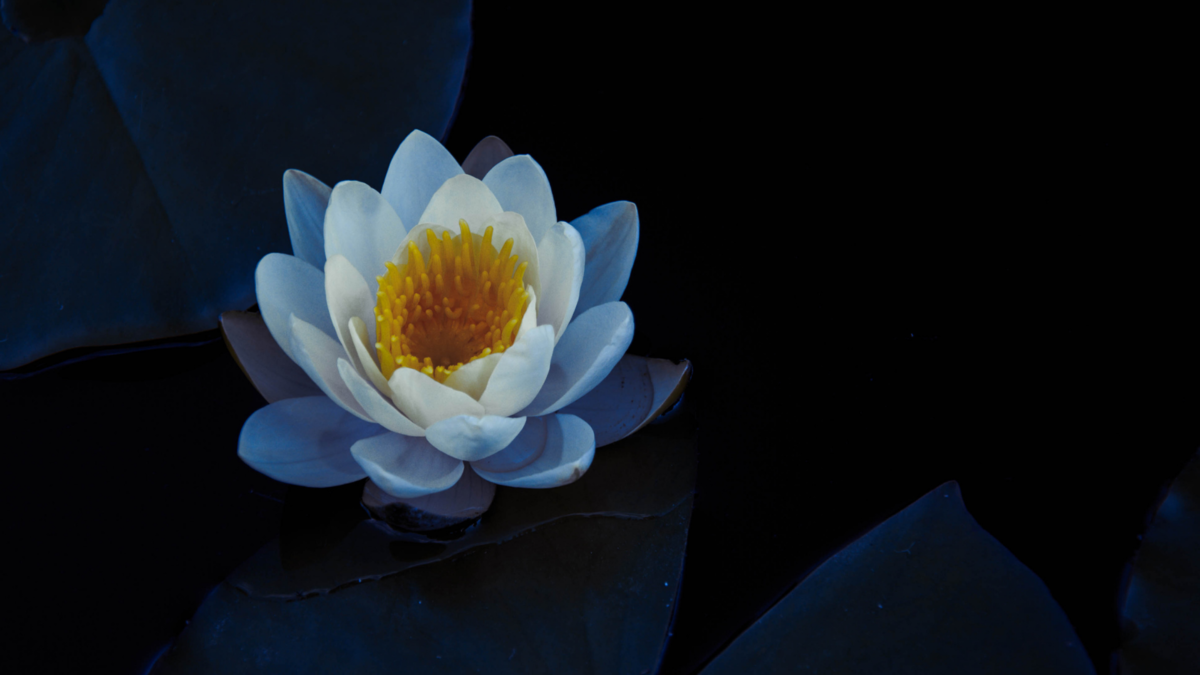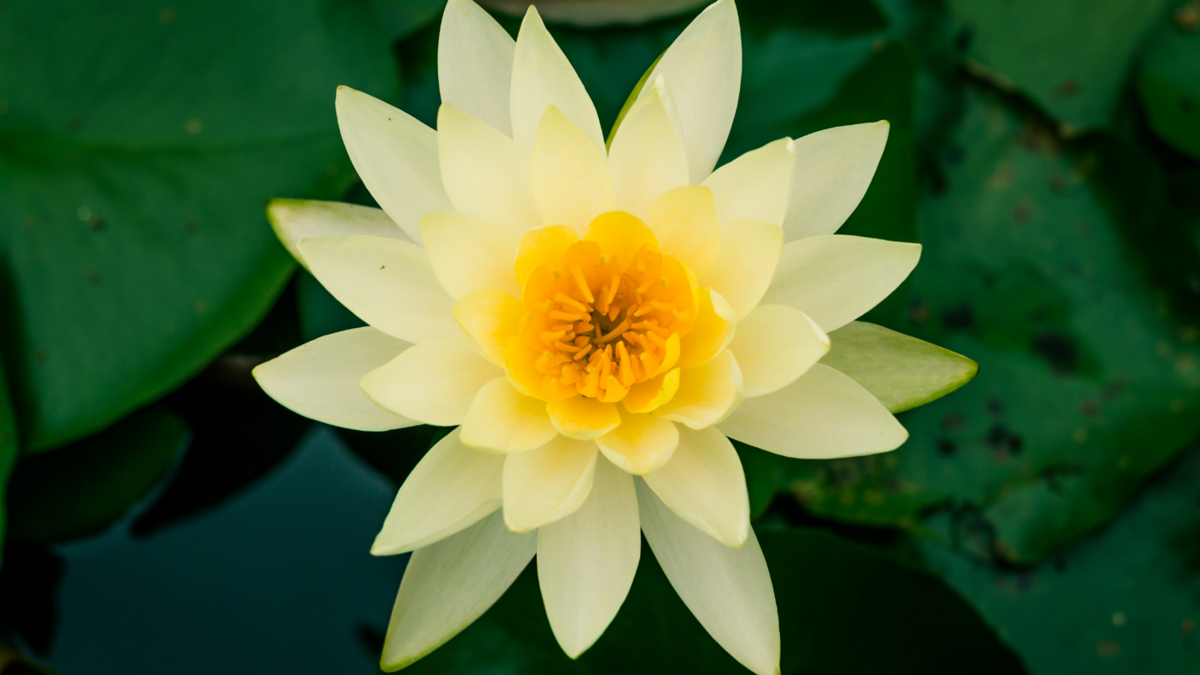Table of contents
What is a lotus flower?

The lotus flower is a flower that originated in India, but is very famous throughout the Asian continent. It is a freshwater flower that grows in swamps and remains above the water. During the night, it closes and remains submerged, avoiding dust and always remaining beautiful.
In fact, beauty is one of its striking attributes. It is a majestic flower because, in addition to its vibrant colors, it is large, at about 50 cm, and inevitably stands out. Moreover, it is a perennial flower that stays alive despite the seasons, blooming fully in summer.
Because of its striking characteristics, it is a very strong symbol in Eastern cultures and especially in Buddhism. This happens because its cycles of recollection and blossoming are associated with life and death, and spiritual elevation. Below are many of the aspects of this world famous flower. Follow along.
Symbology of the lotus flower

In general, for Eastern cultures and having influenced Western cultures as well, the lotus flower has a symbology associated with spiritual elevation and contact with the divine.
This meaning is given for a few specific reasons. First, because the lotus flower is born over water, so that its root lies under the water and its petals over it. Every day it picks itself up and blooms again, remaining beautiful despite the mud that surrounds it.
Thus, all the symbolism of the two worlds, material and spiritual, is seen in it as the representation of this limit that reveals perfection. Besides, it is a very beautiful and delicate flower and, therefore, it also brings the idea of the divine through aesthetics, of that which fills the eyes and enchants.
The following describes some important aspects that make this flower full of spiritual, philosophical and mystical meanings. Follow along!
A sacred flower
The lotus flower is considered a sacred flower because, in addition to enduring through the phases of the year and always blooming again, it has medicinal effects that can prevent against diseases and help regulate blood sugar.
In addition, there are records that it would effect deep sleep and cause amnesia. As a symbol, it is very much related to spiritual elevation and consciousness, purity, truth and enlightenment.
In Hindu mythology, it is said that in the first steps of Siddhartha, who would later become Buddha, seven Lotus flowers were born, each representing a step of spiritual elevation.
The life cycle
It is quite common for the lotus flower to be associated with the cycle of life. This is because its blooming is perennial and it survives all seasons of the year, changing according to the conditions.
Its roots grow in winter, in the mud of the water on which it is kept alive. In spring, it is that the flower blooms, and it is in summer that it really blossoms. In autumn, the flower dries up, but does not fall, restarting the cycle every year.
This capacity for resilience and rebirth in the face of difficulties is what makes it considered a symbol of the cycle of life.
Open heart
The blooming of the lotus flower is something very symbolic, as it starts in autumn and ends in summer, so as the flower is relatively large, around 50 centimeters high, when it finally blooms, it creates a spectacular sight.
In this way, because of the relationship of its symbolism with divine truth, love and spiritual elevation, it is associated with the open heart, because it is from the heart that the human being emanates its light and feels love.
Renaissance
The lotus flower follows the seasons and although it dries up during winter, it does not fall and blooms again in summer. Thus, it is a flower that gets dry and shrinks at one stage of the year and becomes exuberant again in summer.
This accompaniment of the climatic phases of the year brings the lotus flower an association with rebirth, of life after death. Nature is full of cycles of life and death and this is a truth present in human life in various aspects. The lotus flower is therefore associated with rebirth, which is also linked to spirituality in general.
Spiritual awakening
Spiritual awakening is commonly associated with the lotus flower and this has to do in part with its process of death and rebirth, represented in the seasons of the year. In part with its association with Buddhism and with consciousness-expanding cultures that use its image as symbolism.
One way or another, both physically and symbolically, the lotus flower has a very strong presence associated with spirituality, because it is the representation of that which is born from the ashes and becomes beautiful and exuberant, close to perfection, as occurs with the evolution of the spirit.
Meaning of the white lotus flower

The lotus flower can have many colors and, because it is a sacred flower, each of its possible colors reveals a specific meaning. Although in general the lotus flower is associated with purity of spirit, in the case of the flower in white, this message is even more present.
The following are specific definitions of these attributes of the white lotus flower, namely, purity of spirit and fertility, which are associated with its meaning.
The purity of spirit
The white lotus flower, more than any other, is strongly linked to the idea of purity of spirit. By itself, this flower is already associated with spiritual elevation, with enlightenment. However, in the case where it appears white, this indicates the immaculate spirit, healing, truth.
Thus, it is possible to attribute the virtues of honesty, holiness, chastity, integrity and purity, always with a spiritual bias, in the representations or in the actual existence of a white lotus flower.
Fertility
Fertility is above all the origin of life, since it represents the path to new life. The white lotus flower also brings the aspect of fertility in that the creation of new life is always the work of purity and the elevation of the spirit.
The lotus flower is also commonly associated with the feminine, for its delicacy and an idea of welcome as well. Fertility is also revealed by this association.
Meanings of the blue lotus flower

The lotus flower can also be blue. The color blue, in general, is associated with spirit and knowledge, with absolute truth and perfection. Blue appears in the representation of that which is infinite, powerful and perfect, such as the sky and the sea.
The spirit, when represented by blue, is about the victory of the spiritual world, about this energy that dominates and controls for perfection. Thus, the blue lotus flower brings this atmosphere of power and at the same time truth.
The following are better detailed these very powerful aspects, namely wisdom and knowledge and the victory of the spiritual world.
Wisdom and knowledge
The blue color refers to truth and perfection. For this reason, wisdom and knowledge are also attributes associated with the blue lotus flower. Both wisdom and knowledge are constitutive elements of the absolute and divine truth, of what is sought for a full life, and, therefore, aligned with the divine purposes. The blue lotus flower brings this representation.
The victory of the spiritual world
Blue is associated with the victory of the spiritual world, because colors, in general, bring representations of energies. When energy is represented by the color blue, it is, because it has already transmuted and is operating in perfection.
Thus, the blue lotus flower is associated with this meaning and is therefore very powerful. It is also common to always find this flower closed, never exposed, like the spiritual world, which preserves itself and reveals itself only when necessary.
Meaning of the red lotus flower

The lotus flower can also appear in red color and in this case it is associated with love and passion. Red is the color of intensity, of blood, of the heart. Love thus appears as the fuel of evolution and redemption, even thinking of death as an instrument for a new life.
The following details the aspects of love and passion and compassion and generosity associated with the red lotus flower.Check it out.
Love and passion
Love and passion bring the idea of intensity, of fire that burns, creating energy for the miracle of life to materialize. Thus, the lotus flower in red refers to the realization of love, sacrifice, and passion that is incandescent and brings people and situations together.
Compassion and generosity
Red also refers to the less intense attributes related to love, such as compassion and generosity. Thus, the red lotus flower is not only associated with romantic, passionate love, but also with the loving issues of caring and welcoming.
Meaning of pink lotus flower

The pink lotus flower is the most significant of all the colors in which it may appear. This is the one most associated with enlightened personalities, especially Buddha, whose representation is always drawn on a lotus flower.
Below are some of the meanings associated with the pink lotus flower, such as expansion of consciousness and spiritual enlightenment.Follow along.
Expansion of consciousness
The passage through the earth is seen by many religions and philosophies as a journey of evolution, along the path of wisdom.
In this sense, the expansion of consciousness is precisely that moment of integration between the individual and the universe and creation, which is what actually brings happiness. The pink lotus flower is associated with this process of healing and liberation through the expansion of consciousness.
Spiritual enlightenment
Together with the expansion of consciousness, spiritual illumination occurs at that moment when the human being stops seeing himself as a product of the earth and understands himself as light, and part of a divine plan.
The pink lotus flower is also associated with spiritual enlightenment, as this possibility of integration with the truth and the divine, and is therefore also linked to the great masters who have passed through the Earth.
Meaning of the purple lotus flower

Purple is the color of transmutation in spirituality and can be associated with inner peace and affective work for the elevation of the being. Thus, the whole issue of emotions and the individual's view of himself and others are associated with this color.
When the lotus flower appears in the color purple, all these issues are raised. The following is the definition of the aspects of harmony of feelings and receptivity and respect, associated with the purple lotus flower.
Harmony of feelings
Inner peace comes with the understanding of feelings and welcoming the affectivity of oneself and of others. For this reason, the purple lotus flower is related to this understanding of the multiplicity of feelings that exist in the human being, as well as the ability to live in harmony with all of them.
The harmony of feelings is what first enables the process of expanding the consciousness of the human being, as he begins to observe and accept his nature and understand the divinity that exists within himself.
Receptivity and respect
The purple lotus flower is also associated with receptivity and respect, inasmuch as community life is a prerequisite for harmony and joint evolution. Even though the processes of spiritual elevation are individual, life happens together, and all are constantly affected by all in a second process of group evolution.
For this reason, the energy of receptivity and respect, in which there is acceptance of the truth of the other, is essential for the attainment of the divine in its completeness. The purple lotus flower is associated with this need.
Meaning of the yellow lotus flower

The yellow lotus flower appears in the context of joy, life, light and creative energy. Also, it is very associated with intelligence, and solutions by sagacity and commitment to observe life in a light and happy way.
The following are better defined these principles, such as the joy of detachment and intellectual spirituality, associated with the yellow lotus flower. Check them out.
Joy of Detachment
The best way to face life's obstacles, which sometimes seem insurmountable, is through joy, which is necessarily related to the idea of detachment. This is because it is impossible to move forward and find the truths of the universe by being attached to facts or things through attachment.
Thus, the yellow lotus flower is associated with the magic of joy through detachment, of acceptance of things as they are with a sincerely happy vision of being able to observe life as it is, regardless of how one wishes it to be.
Intellectual spirituality
Intelligence is also a form of expression of the divine, in that it comes from a series of experiences that accumulate in the mind, a veritable library of life.
In addition, having an intellectual vision of spirituality is a way to help the world on its journey together, since this process is extremely individual and difficult to share. The yellow lotus flower brings this representation of the spirit translated by knowledge.
Meaning of the lotus flower in different cultures

Because of its striking characteristics, such as its cycles and exuberance, the lotus flower is commonly associated with various cultures, being the ultimate symbol of spiritual elevation, especially for Buddhism. In general, it is in the East that it gains greater prominence, also because it is a plant originally from India.
Below are some definitions of the meaning of the lotus flower in different cultures, such as Chinese, Japanese, Egyptian, and even when it is represented in tattoos, which is quite common. Check it out.
The lotus flower for the Egyptians
The lotus flower was also much worshiped in ancient Egypt, there are drawings of lotus flowers inside the Pyramids. In this culture, the lotus flower is associated with the creation of the world. The story goes that the sun god, Horus, would have been born from a lotus flower.
The lotus flower for Hindus
In Hinduism, the lotus flower is often represented as a symbol of divinity. In Hindu mythology, the story is that there would be a lotus flower in the navel of the god Vishnu, from which another deity would have been born, the god Brahma, the great creator of the Earth, of men and of the whole universe.
The lotus flower for Buddhism
Despite its relationship with many religions, it is in Buddhism that the lotus flower finds its meaning most strongly associated.
This is because the lotus flower is the symbol of purity and spiritual elevation, just the way Buddhism preaches. Legend has it that when Buddha took his first steps, lotus flowers were born wherever he went, and for this reason, it is very much associated with the figure of this master, this being one of the strongest symbols of Buddhism.
The lotus flower for the Greeks
In Greek mythology, the lotus flower is associated with rebirth. The story tells that in Homer's Odyssey, warriors ate lotus flower, which had the effect of creating drowsiness and amnesia. This forgetfulness was seen by the Greeks as a chance for a new beginning and, therefore, the possibility of rebirth within oneself.
The Lotus Flower for Christians
The Catholic Church has a recognized difficulty in accepting other religions, always defending the idea that the Christian faith should be One and Universal. However, there is an Asian current of Christianity, not founded in the Roman Church, but that seeks the teachings of Jesus in Palestine, which accepts the teachings of both religions.
Thus, the symbol of this current is a cross on a lotus flower, and in its philosophy there is the truth of Jesus' teachings, but it also accepts the spiritual enlightenment advocated by Buddha.
The lotus flower in yoga
The lotus flower in Yoga is what is called the best known and most used position for the practice of Yoga and meditation. Thus, the lotus flower position is when the person sits with legs crossed and puts his arms on his knees.
The name is given because the figure of the person ends up looking like the lotus flower, but also for all the divine meanings. Yoga is closely linked with the Hindu and Buddhist oriental culture, where the symbology of the lotus flower is extremely strong.
The lotus flower in Victorian England
The Victorian era was the time around the 18th century in England when flowers were very present in all forms of expression, from art, to literature and fashion. At that time, there was a science that was called Floriography, in which each flower wanted to say something specific.
In the case of the lotus flower, in the Victorian era, its meaning was associated with eloquence, which refers to the ability to speak and express oneself with ease.
The lotus flower for the Chinese
In China, there is a popular saying that goes "be pure, like the lotus." The purity of the lotus flower is associated with this ability for it to come out of the mud every day and remain clear, which is associated with the idea of overcoming and elevation.
Moreover, in China the plant is also ingested for its medicinal properties. The seeds are used to take care of blood pressure and the flower itself is eaten breaded, fried and with sugar.
The lotus flower for the Japanese
For the Japanese, the meaning of the lotus flower is closely associated with that of Buddhism, in which it emanates purity, spiritual elevation, and redemption. Because of its ability to leave and enter the water under the mud every day, it is associated with its meaning of purity. In Japan, it is widely depicted in manga and anime.
The lotus flower for the Vietnamese
The lotus flower in Vietnam is the country's national flower. This means that it is represented in various cultural expressions, i.e. it is part of the identity of the Vietnamese as a nation.
This is largely because of the symbolism of the flower throughout the Orient. However, what is restricted to religion and philosophy in other countries is a matter of state for Vietnam.
The lotus flower as tattoo
Tattooing the lotus flower on your body means bringing to you, in a permanent way, all the meanings associated with this divine flower, especially in the aspect of spiritual evolution. Thus, it is a very positive image to have tattooed, as it refers to spiritual enlightenment, purity, divinity, and even resurrection.
What is the spiritual significance of the lotus flower?

The Lotus flower itself is a representation of spiritual elevation. For this reason, whenever it appears as a symbol it is associated with the presence of the divine, the expansion of consciousness, the elevation of the spirit.
The lotus flower is about this contact with truth and purity, which, in a more or less mystical way, inevitably leads to enlightenment and inner peace. This is linked to its ability to collect itself and blossom under the mud every day, without getting dirty with it. Moreover, it endures the winter almost dry and then is reborn in summerblossoming.
Thus, the lotus flower is closely linked to spirituality by the idea of evolution of the being through resilience and maintenance of values. By the concepts of attitudes, such as respect, compassion, discernment and love, it is related to the ideals of enlightenment of great spiritual masters, such as Buddha.

